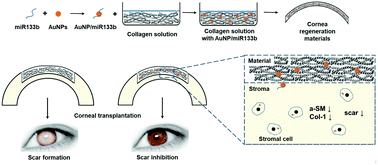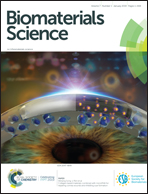Collagen-based materials combined with microRNA for repairing cornea wounds and inhibiting scar formation†
Abstract
The cornea repair materials amniotic membrane, acellular corneal stroma, and natural polymer-based materials have excellent biocompatibility and support epithelization. However, few researchers have focused on corneal stromal wound healing repair with regard to scar formation and transparency improvements. Herein, we introduced nanocomplexes of gold nanoparticles (AuNPs) and microRNA-133b (miR-133b) into collagen-based material to achieve corneal repair and scar inhibition. We evaluated the cytocompatibility of AuNPs and the ability of miRNA-133b to inhibit myofibroblast transformation in vitro. The AuNPs had no cytotoxicity at working concentrations, and AuNP/miR-133b complexes down-regulated the expression of myofibroblast transformation genes (alpha-smooth muscle actin and type I collagen) in corneal stromal cells. We then loaded AuNP/miR-133b complexes into collagen using two methods: loading on the surface (Col-AMS) and loading inside (Col-AMI) the collagen membrane. The results showed that AuNP/miR-133b introduction did not affect water content, light transmittance, or the mechanical properties of the collagen membrane. MiR-133b can maintain its integrity during the preparation of materials. In vivo lamellar keratoplasty results showed that the cornea epithelized completely and rapidly. Corneas without transplantation and with the transplantation of a non-modified collagen membrane became cloudy after trauma to different degrees after approximately 14 days. Interestingly, cornea transparency was retained after transplantation with Col-AMS and Col-AMI. Hematoxylin–eosin-stained histologic sections revealed that the corneas transplanted with Col-AMS and Col-AMI were similar to healthy corneas. Immunohistochemical staining revealed lower a-SM and Col-1 expression in corneal stroma after transplantation with collagen combined with AuNP/miR-133b. Our results thus suggest that collagen membranes combined with AuNP/miR-133b complexes can rapidly repair corneas and effectively inhibit scar formation.



 Please wait while we load your content...
Please wait while we load your content...